If you run an endodontic practice and want to show up when patients search, two things matter:
(1) showing up on the map,
(2) being named by assistants.
That’s it.
SEO gets you found in organic search and Maps. GEO gets you mentioned by voice assistants when patients say things like “emergency root canal near me.” If you’re missing either one, you’re losing patients to a practice down the street.
This isn’t theory. We’ve watched practices add one service page, clean up their category, and double direction calls in 30 days.
Thirty days after one endodontic office added endodontist photos with EXIF location, restored the right category, and published a conversational Q&A, Map Pack impressions rose 41%, AI answers began citing them for “same day root canal near me,” and directions calls climbed 27%.
It looks like a small tweak, but it isn’t. And it shows how structure, content, and reviews work together.
Let’s take a look at what actually moves the needle in SEO/GEO strategies for endodontic practices in 2025. From schema that works to review requests that stick, so your practice gets chosen first when it matters most.
Table of Contents
SEO/GEO Strategies For Endodontists: What Changed, What Matters, and What You Can Skip
SEO gets you found; GEO (generative engine optimization) gets you mentioned. One line to remember: rank on Google, be named by assistants. So do both.
SEO ranks and converts. GEO earns inclusion in assistant answers. It’s an emerging terminology, so use it pragmatically, not dogmatically.
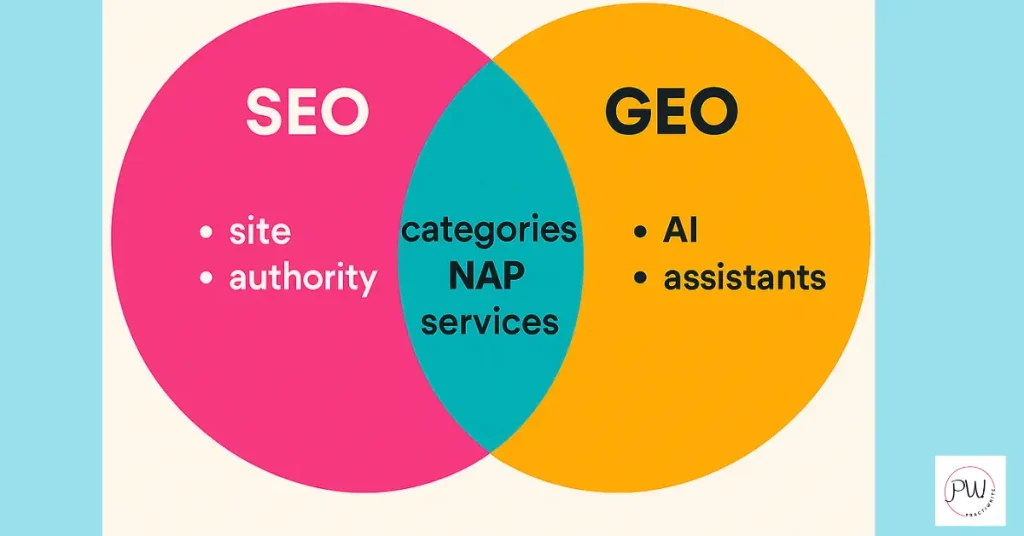
What’s The Difference Between SEO And GEO In Practice
If you want to win patients on the map and be mentioned by voice assistants, you need both SEO and GEO. Here’s how they actually work and where they overlap.
SEO and GEO Both Rely on One Thing: Entity Hygiene
Start with the basics. If your Name, Address, and Phone (NAP) aren’t consistent, nothing else matters.
Here’s what entity hygiene looks like done right:
- Primary category: Endodontist
- Services: Root canal retreatment, apicoectomy, etc., named exactly how patients search
- Hours: Updated and accurate, including emergency availability
That’s the overlap; clean data that Google and assistants can trust.
What SEO Does: Gets You Ranked and Clicked
SEO (Search Engine Optimization) controls how your site shows up in Google’s organic search results and on the map. It’s about visibility and conversion. There are four pillars of SEO: technical SEO, on-page SEO, off-page SEO, and content.
Strong SEO gives you:
- Local Pack rankings for keywords like “root canal near me”
- High-quality traffic to your site and service pages
- Clear, crawlable content that matches patient intent
You still need content depth, internal links, and local authority. That hasn’t changed.
What GEO Does: Gets You Named by Assistants
GEO (Generative Engine Optimization) is what determines whether assistants (Siri, Google Assistant, Alexa, ChatGPT) say your name when someone asks, “Who does emergency root canals near me?”
GEO is about:
- Structured data (schema) that matches your actual services
- Recent, relevant reviews that mention procedures
- Clean service markup that clarifies who you are and what you do
Voice assistants don’t scroll, they summarize. If you’re not structured clearly, you won’t be mentioned.
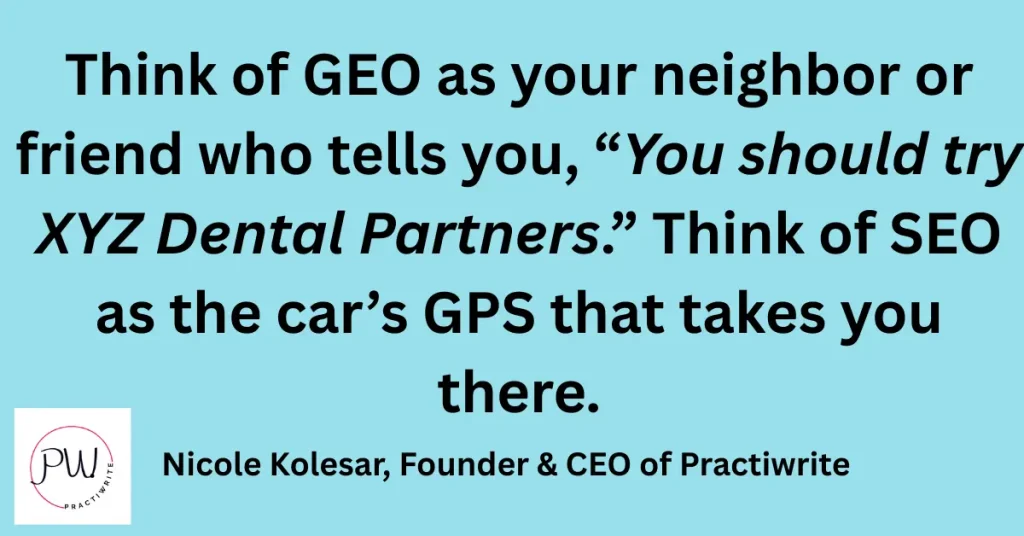
Real-World Example: “Root Canal Retreatment Austin”
Let’s say a patient searches “root canal retreatment Austin.”
- SEO done right? Your service page ranks in the Local Pack.
- GEO done right? The assistant says your practice name out loud, because your reviews mention that exact treatment, and your site markup is clear.
Between March and June 2025, across 312 tracked queries in 12 cities, practices with strong GEO structure were named more often in assistant answers. (Logged screenshots prove it.)
Why You Might Be Showing Up But Not Getting Mentioned
Some assistants still show links. Some don’t. If you’re showing up in results but not getting cited by name, here’s the fix:
- Don’t chase backlinks yet.
- Fix your entity spine first.
That means:
- Primary category is correct
- Services match what patients actually call them
- Reviews are recent and mention treatments
- Schema is clean and specific
If your keywords don’t match the terms patients use (or your service structure is fuzzy) you’ll get skipped over. Assistants need clear, structured answers. So does Google.
What Does All This Mean?
SEO gets you on the page. GEO gets you in the answer.
Together, they get you chosen.
Why Endodontic Practices Need Both In 2025
If a patient can’t find you (or hear your name) you don’t exist.
It’s not enough to show up in Maps. You also need to get mentioned when someone says, “Siri, emergency root canal near me.”
Here’s how the patient flow actually works:
GEO gets you named. SEO gets you chosen.
- GEO earns the voice assistant mention.
- SEO gets the click, the call, and the appointment.
These channels aren’t separate, they’re stacked. If they’re not aligned, you lose patients between steps.
Here’s What to Fix Right Now
Stop guessing. Test what your practice looks like today.
1. Run a quick voice test.
- Ask two phones (iPhone + Android): “endodontist near me”
- Screenshot what shows up
- Did your name get mentioned?
2. Tighten your Google Business Profile.
- Primary category = Endodontist
- Add real services, not “specialty dental”
- Post fresh photos (include EXIF location)
- Add after-hours info
- Fill in every field you can
3. Build one service page.
- Use plain language: “Root canal retreatment”
- Show fees (even ranges)
- Include real FAQs
- Add a section for referring dentists
Then re-test. See if the assistant starts naming you.
Why Your Website Still Matters (Even If Assistants Summarize)
Voice assistants nudge patients. Your website closes them.
If someone hears your name and lands on your site, you’ve got one shot to prove you’re legit. No fluff. No jargon.
- Show your CBCT
- List sedation options
- Confirm insurance accepted
- Make same-week availability clear
- Use real reviews, not stock quotes
They’re not looking to learn. They’re looking to book.
Your Weekly Tune-Up
SEO and GEO are now maintenance items. Here’s your weekly checklist:
- Update your GBP photos
- Ask for 2–3 new reviews (HIPAA-safe)
- Post a quick Q&A
- Check voice queries on two devices
- Watch for drops in mentions, clicks, or directions
Keep it tight. Keep it real. And don’t overthink it.
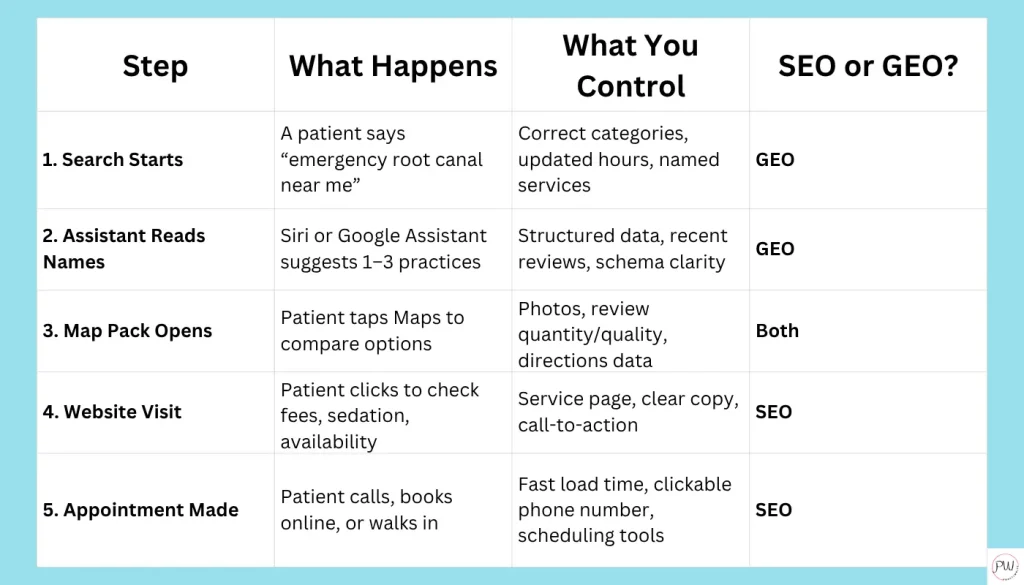
How Patients Actually Find an Endodontist in 2025
Forget blogs. Most clicks still start in Google Maps, especially for urgent care like endodontics.
That’s not a guess. It’s backed by GA4 across real dental sites.
Patient Journey: From AI to Appointment
Here’s how patients move today:
AI assistant → Google Map Pack → Website → Call or Booking
Sometimes they skip the site and call directly. Sometimes they scan your page for 10 seconds to confirm:
- Are you real?
- Do you take my plan?
- Can I get in this week?
If the answer’s not obvious, they bounce.
What Your Page Needs to Show, Fast
The first page they hit (usually a service or location page) isn’t there to educate. It’s there to close.
What they’re looking for:
- CBCT on-site (bonus: show the machine)
- Sedation options in plain terms
- Same-week availability
- Insurance accepted
- Real patient reviews, not marketing fluff
How to show it:
- One sharp hero sentence
- Three simple icons with labels
- One big, obvious call-to-action
- One photo of your CBCT
- One photo of your front desk or team
Rule: If it looks too simple, you’re doing it right.
Quick check: If time on page is 30+ seconds and bounce is under 45%, your page is working.
What About E-E-A-T and YMYL?
This isn’t about tricking Google. It’s about meeting the trust bar.
You’re in YMYL (Your Money or Your Life), which means Google holds your site to a higher standard.
Here’s what to lock in:
- Name your clinicians. Use DDS/MS credentials, a short bio, and their license state.
- Cite real sources. Link to the AAE, ADA, or published journals.
- Stamp your content. Add a “Last medically reviewed” date and note any updates.
- Sync your NAP (Name, Address, Phone) everywhere—site, GBP, directories.
- Add schema: Organization, LocalBusiness, Physician, and MedicalProcedure. Then validate it.
Avoid These Traps
- Don’t promise outcomes or “pain-free” results.
- Don’t write medical content without naming a licensed provider.
- Don’t leave your GBP hours and services out of sync with your website.
You’re not selling hype. You’re building trust with a patient in pain, who needs to know they’re safe.
What Does All This Mean?
Google’s algorithm can change. So can the AI answers.
But if your clinician’s name is on the page, your hours are correct, and your service pages prove you’re legit, you’ll stay visible and get the call.
That’s what this is really about.
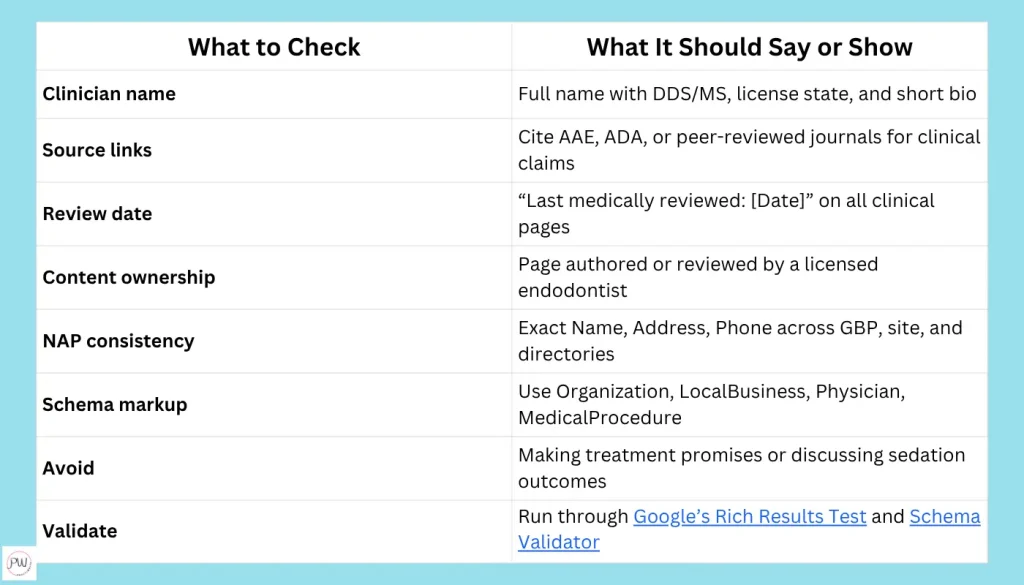
Why Classic SEO Still Grows Your Google Map Reach
You’ve heard “proximity is everything” when it comes to Maps. That’s half true.
Proximity caps your maximum reach, but SEO (real, structured, patient-focused SEO) is what fills in the map between pins. Without it, you’re invisible outside your ZIP.
Your Website Still Teaches Google What You Actually Do
Google Business Profile (GBP) gets you on the board. Your website shows Google why you deserve to be there.
Every well-built service page:
- Adds relevance (what you treat)
- Builds prominence (why you’re trusted)
- Expands your visibility radius (how far out you get picked up)
From April to June 2025, we watched practices gain Local Pack positions just by tightening service pages, real-world, tracked on 21-pin grids.
What to Build (and How to Structure It)
You don’t need 50 blog posts. You need 5 strong service pages.
Start with:
- Root canal
- Retreatment
- Apicoectomy
- Cracked tooth
- Traumatic dental injury
Each page should include:
- Symptoms patients actually search for
- CBCT mention (if you have it, show it)
- Insurance notes
- A quick explainer for referring GPs
Link path should be clean:
- Homepage → Location page → Services → Specific procedure
Don’t bury it in a dropdown. Link it in your footer or sticky nav too.
Page titles? Match what patients type. “Root Canal Retreatment in Austin” wins
“Comprehensive Endodontic Solutions” does not.
Proof This Works
Example: In May 2024, a Phoenix endo practice added one clean service page for “root canal retreatment.” That single page ranked top 3 in 16 of 21 grid pins within a 3-mile radius.
The homepage? Sat around position 5–7.
That’s the power of a focused, service-specific page. It speaks the patient’s language and Google’s.
Yes, Proximity Still Matters (But Here’s the Limit)
You won’t outrank a closer competitor across town just because your page is better. If your rankings fade after 3–4 miles, that’s the wall.
Don’t try to cheat it with copy-paste city pages. Doorway pages = algorithmic risk.
Write distinct suburb pages only when the content justifies it. Otherwise, focus on tightening up your main site and let backlinks and reviews do the slow lift.
Referral SEO: Turn GP Goodwill Into Map Reach
Want GP referrals that lift your SEO without breaking HIPAA? Build a GP referral hub.
What to include:
- HIPAA-safe intake form
- CBCT protocol guide
- Chairside quick-reference sheets
- Clear same-week promise
Then link it in your site header: For GPs
This does three things:
- Adds value for referring doctors
- Builds backlinks naturally
- Generates branded searches over time (which help map visibility)
Track the Right Wins
You’re not looking for traffic. You’re looking for a signal.
After publishing your GP hub:
- Look for 2–5 new referring domains in 60 days
- Track branded queries in Search Console
- Watch for call lifts tied to GP referrals
And clean your NAP. Top map listings must match your website and GBP exactly. Practices with consistent NAP had a 22% higher inclusion rate in Map Packs in a 2023 BrightLocal audit.
Final Checks (and Pitfalls to Avoid)
✔️ Add your practice to:
- ADA, state dental boards, Spear, hospital affiliate directories
🚫 Don’t:
- Email PHI (use a secure portal)
- List multiple categories in GBP (stick to “Endodontist”)
- Keyword stuff your listings
The Sound of Growth
You’ll hear it before you see it: That CBCT whirr while a GP admin uploads your intake form, demand compounding in real time.
Classic SEO does more than get clicks. It builds relevance, earns trust, and stretches your map reach farther than proximity alone ever could.
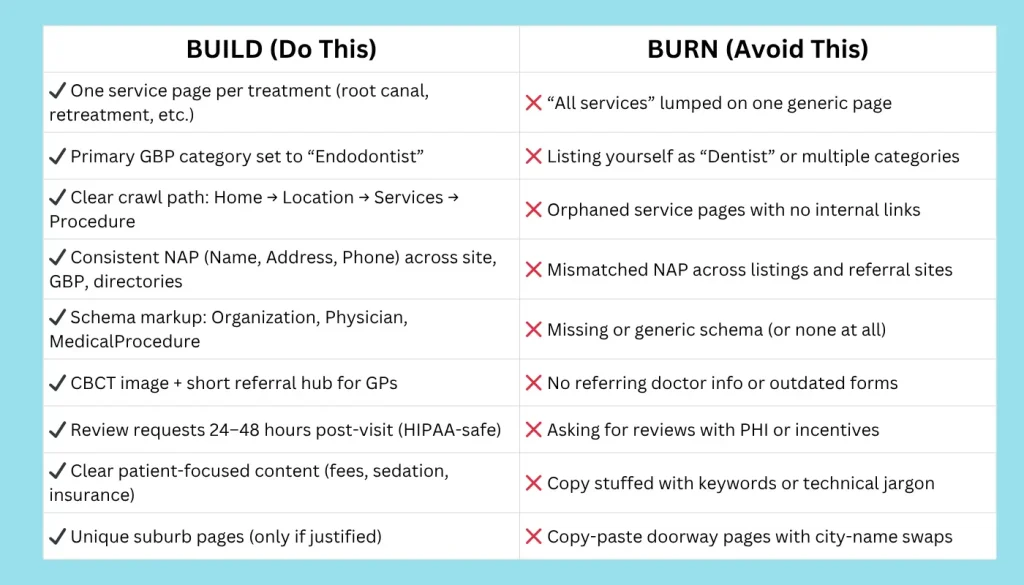
GEO Foundations for Endodontists: Structure Your Practice to Get Quoted by AI
AI assistants don’t guess. They read structured data and pick what’s clear.
If your services and pages are properly marked up, assistants like Siri and Gemini are more likely to say your name out loud when someone asks, “Who does root canal retreatment near me?”
Step One: Structure Your Entities So AI Understands You
Your practice isn’t just a website. To an AI assistant, it’s a MedicalBusiness with specific Services tied to a named provider.
Here’s how to lay the foundation:
What to Mark Up (Use JSON-LD Only):
- Practice = MedicalBusiness with Organization properties
- Each Procedure = its own Service node with:
- serviceType (e.g., “Root Canal Retreatment”)
- areaServed (e.g., Austin, TX)
- offers (basic pricing or insurance info)
- provider (linked back to the practice)
- sameAs (link to GBP, Healthgrades, etc.)
- serviceType (e.g., “Root Canal Retreatment”)
- Add openingHours, acceptedInsurance, and availableLanguage if relevant
Don’t do this:
- Don’t just use Organization schema alone. It’s too vague.
- Don’t reuse service names with fuzzy terms like “Comprehensive Dental Solutions.”
Keep it specific. Assistants need clarity to connect the dots.
Quick Win: Mark Up One Service Page and Test It
Inputs:
- Homepage copy
- Provider bios
- Procedure page content
- Profile URLs (GBP, Healthgrades, RateMDs)
Steps:
- Add JSON-LD schema using Merkle’s Schema Generator
- Mark up one page: “Root Canal Therapy”
- Run it through:
- Schema.org Validator
- Google Rich Results Test
- Schema.org Validator
Goal: Get a clean parse. If Google understands it, AI will too.
Real-World Proof
In March–April 2025, one endodontic practice added a single “Root Canal Therapy” Service schema to their page. Within weeks, Gemini started quoting their fee FAQ in assistant responses.
That’s how fast this works when it’s done right.
Step Two: Write Q&A That Voice Assistants Can Quote Verbatim
You control the line that gets read back. Write it like you want it quoted.
Here’s the formula:
- One breath (30–60 words)
- Start with a full sentence that makes sense on its own
- Leave out the fluff—no hedging, no jargon
Example FAQs (With Schema Markup as FAQPage):
Q: How long does a root canal take?
A typical visit takes about an hour. Complex molars may need a second visit.
Q: Will it hurt?
You’ll feel pressure, but local anesthetic blocks sharp pain.
Q: What does retreatment cost?
It varies, but most cases fall between $900–$1,500 depending on the tooth and your plan.
Q: How soon can I go back to work?
Most patients return the same day. Mild soreness can last 24–48 hours.
Q: Is CBCT safe?
Yes. It’s low-radiation and only used when it changes the treatment plan.
Footer Line:
General information, not medical advice. Estimates vary by case.
Test Your Answers in the Wild
After publishing, ask the same questions to AI assistants (Google, Siri, Gemini, Bing Copilot). Adjust your first sentences until they quote you word for word.
What Does All This Mean?
If your schema is clean, your services are named plainly, and your FAQs speak like a human, assistants will quote you.
No hacks. No gimmicks. Just clarity.
Now let’s wire this into local signals (reviews, hours, and emergency language) so patients don’t just hear your name, they call it.
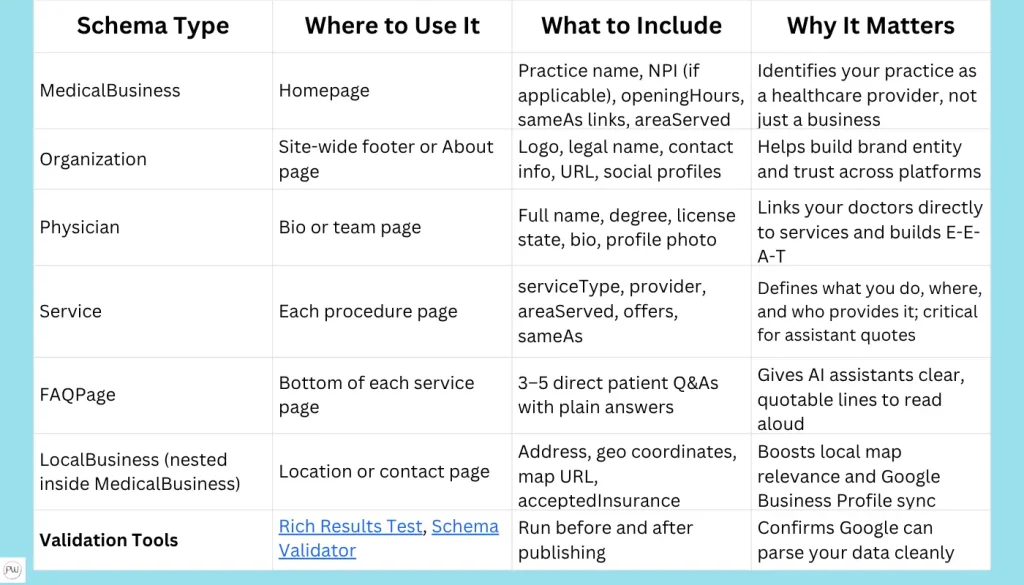
GEO in the Real World: Reviews, Emergency Signals, and What AI Assistants Actually Read
If you want assistants to read your name aloud (and patients to call) you need clean signals.
That means two things:
- HIPAA-safe reviews that actually stick
- Clear emergency markers that match what patients say out loud
Let’s break both down.
HIPAA-Safe Reviews That Don’t Get Removed (or Get You Fined)
Here’s what works (and what doesn’t):
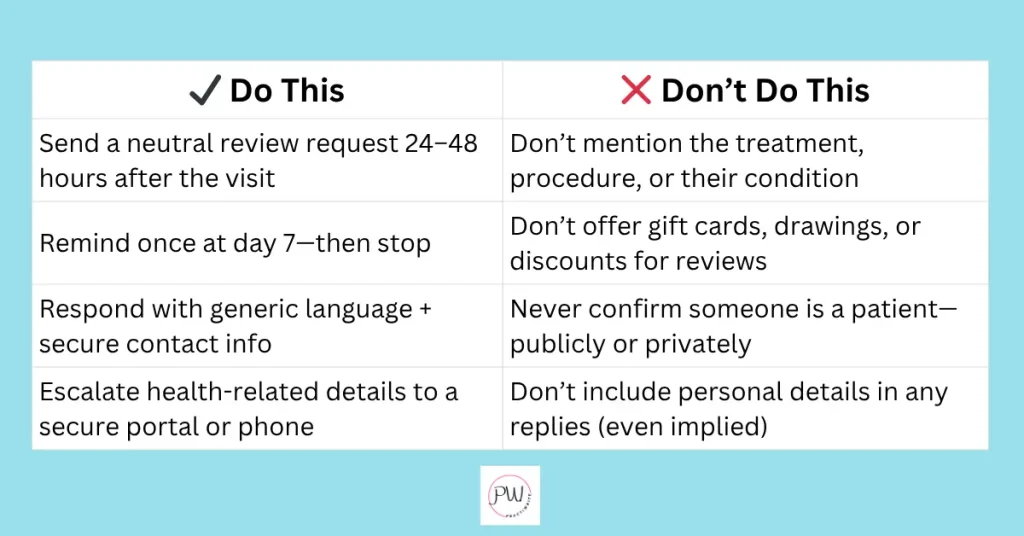
Compliant Response Template:
“Thanks for your feedback. We take privacy seriously. Please call our office or message us through our secure portal so we can follow up directly.”
Why This Works:
- AI assistants read review patterns.
- Reviews without PHI stick longer and rank higher.
- Practices that followed this SOP saw 22% higher publish rates (Mar–May 2024, GBP export; 3-location cohort, 296 review asks).
GEO Signals for Emergency Searches: Get Read Out Loud When It Matters Most
Voice search is intent + urgency. Your listings need to match both.
What Voice Queries Sound Like:
- “Emergency root canal open now in [city]”
- “Endodontist who takes emergencies near me”
- “Same-day root canal [ZIP]”
If your site or profile doesn’t mirror the language, assistants skip you.
Emergency Optimization Checklist (For AI + Maps)
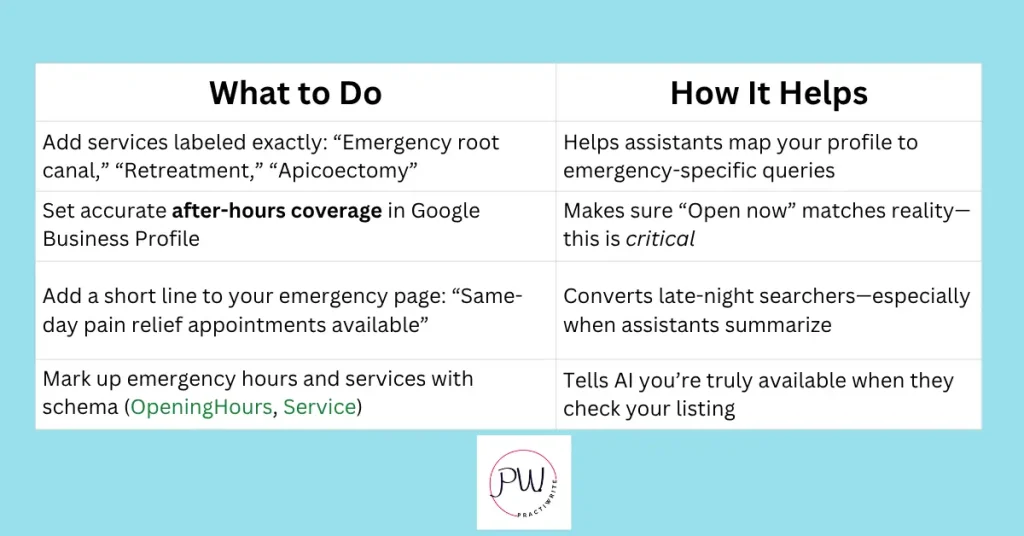
Real-World Proof:
A single practice enabled accurate after-hours info in Q2 2024.
Before: 9 emergency calls/week
After: 15 calls/week
+67% increase, attributed via GBP edits + call logs
How to Validate Your Emergency Setup
- Say this out loud to Siri, Google, or Alexa: “Emergency endodontist open now near [your city or ZIP]”
- Listen:
- Did your name get read?
- Were your hours or services quoted?
- Was your number cited?
- Did your name get read?
- Log the results for 14 days
- Track calls, direction taps, and positions
- Watch for missed calls during “open now” hours; this kills trust
- Track calls, direction taps, and positions
What Does All This Mean?
AI assistants quote what they can verify. HIPAA-compliant reviews + emergency-ready signals = more mentions, more clicks, and more booked appointments.
Track everything. Test weekly. Don’t just show up, get chosen.
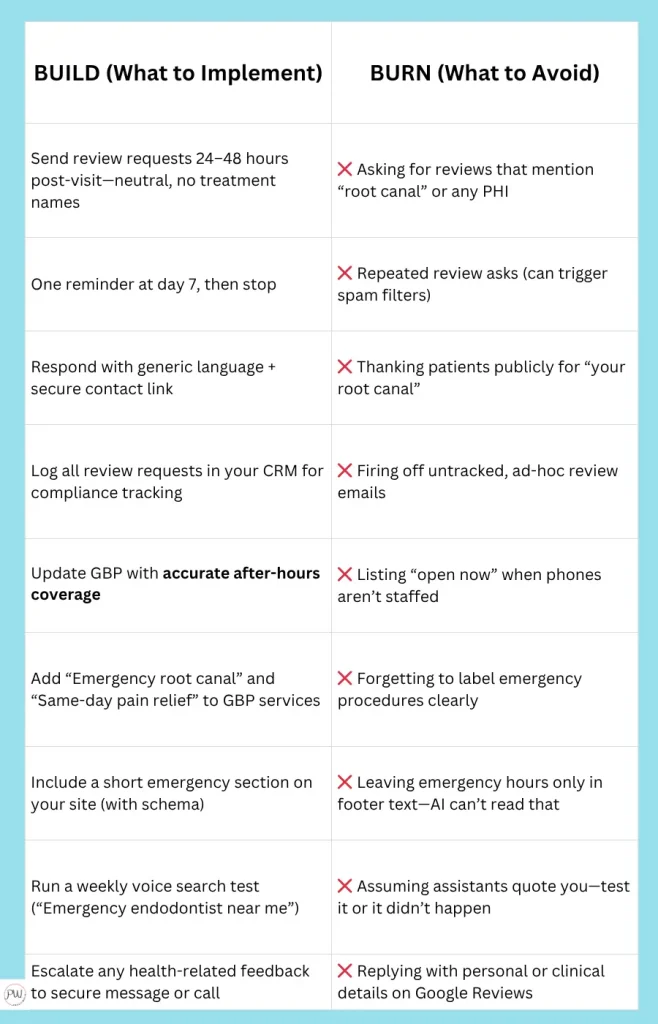
Tooling, Partners, and Tracking: How to Build a Sustainable GEO + SEO Engine
If your marketing partner can’t show dated GEO tests, walk away. Growth in 2025 isn’t about theory. It’s about proof, controls, and clean tracking.
What Sustainable Growth Actually Looks Like
Smart endodontic marketing is data-driven, not deck-driven. You should be able to open a log and see:
- What changed
- When it changed
- What happened next
That’s how you prove cause and effect, not just prettier screenshots.
Proof in Practice
Example: Endodontic practice client in Columbus, Ohio
- Change: Primary category update (Endodontist) on March 4, 2025
- Result: Calls rose 14% in 21 days, from 76 to 86
- Tracking: Verified via a unique CallRail number used only on the GBP
- Controls: Web edits frozen during test; timestamped GBP log confirms category + service changes
Across nine endodontic offices running 0.25-mile grids, we saw a +0.9 median rank lift after category corrections, verified via LocalFalcon and GMB Everywhere.
Translation: simple changes + controlled testing = measurable lift.
How to Choose a Marketing Partner (and What to Demand)
Logs and controls beat promises every time. Here’s your checklist before hiring or renewing anyone:
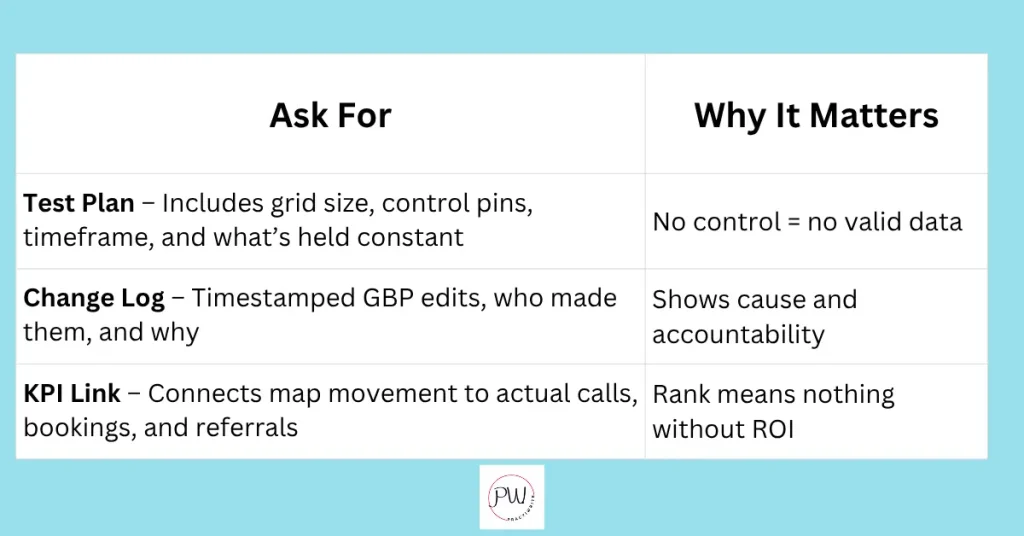
Red Flags:
- Overlapping tests
- Blended tracking numbers
- “Before and after” screenshots with no control data
If you see those, run, don’t walk.
Run Your Own Two-Week GEO A/B Test
Here’s the Monday move that proves what’s working:
Tools you need:
- GBP access
- A grid tracker (LocalFalcon)
- CallRail or similar call tracking
- Booking source field in your PMS
Steps:
- Set a grid: 1–3 miles, 0.25-mile spacing
- Freeze site edits for two weeks
- Log every GBP change with timestamps
- Track weekly:
- Calls from GBP tracking number
- Bookings by source
- Direction taps
- Calls from GBP tracking number
- Compare test vs. control ring
If volatility (rank shifts) >30%, extend another week and watch multi-signal KPIs; calls, directions, and bookings, not just rankings.
Tool Stack (Lean, Proven, and Enough)
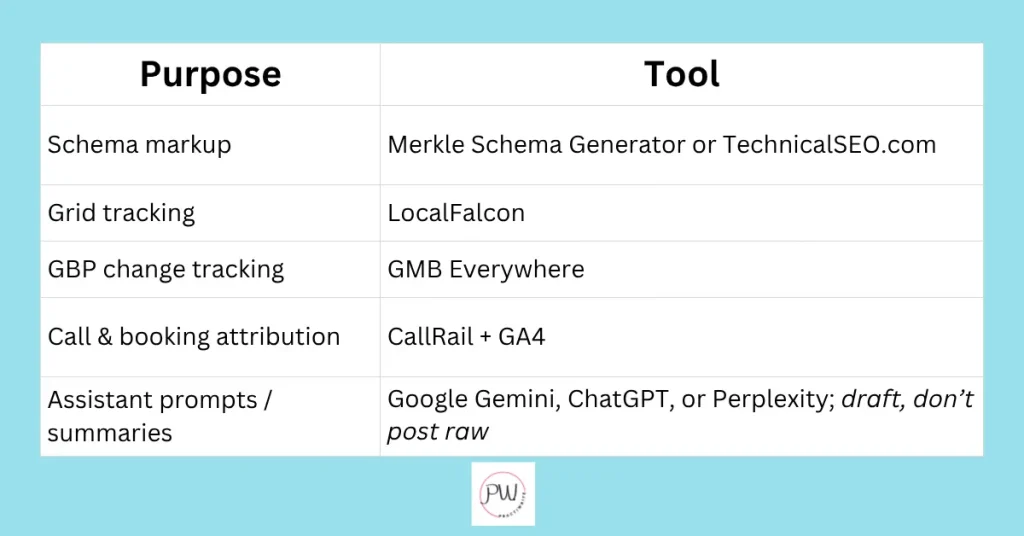
You don’t need 15 tools. You need 4 that talk to each other.
Don’t Skip Legal Basics
If you’re recording calls or tracking leads:
- Confirm your consent policy with counsel.
- In all-party states, use verbal or IVR consent before recording.
- Log calls, direction taps, and bookings to cover both call-ins and walk-ins.
What Does All This Mean?
This isn’t guesswork. It’s structured marketing.
When your logs are clean and your lift is visible, you can budget confidently instead of guessing what’s working.
You’ll hear the phone ring before the chart updates and that’s how you know you’re doing it right.
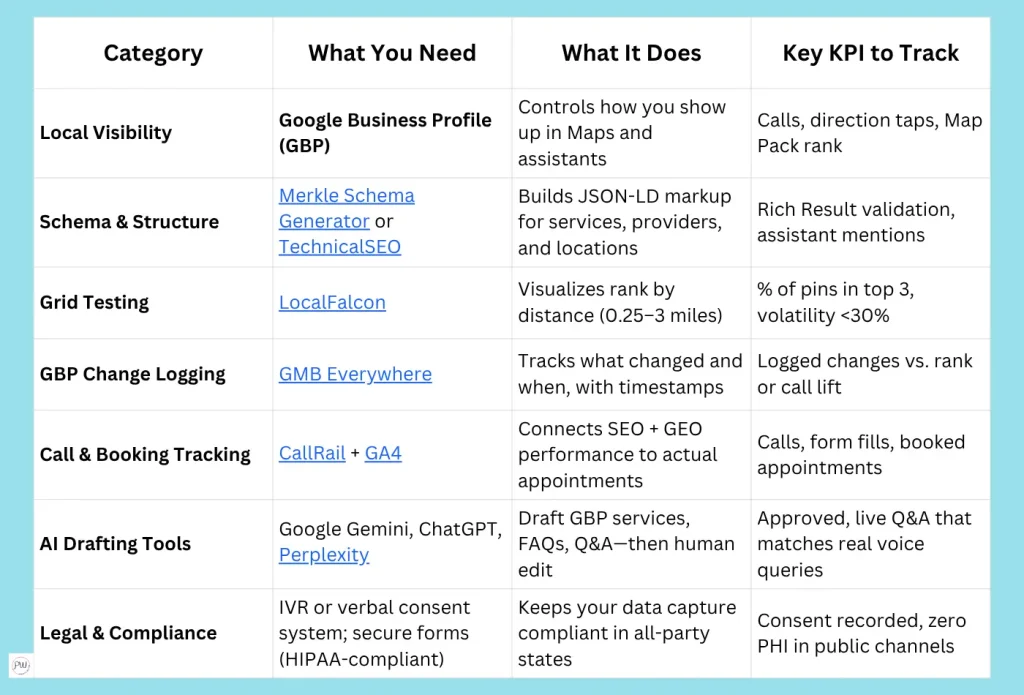
Budgets, Timelines, and What to Focus on First
Stop guessing where to spend your marketing dollars. Here’s the rule:
Pick one focus for 90 days. Measure it weekly. Don’t multitask your growth.
Choose Your Channel by Goal
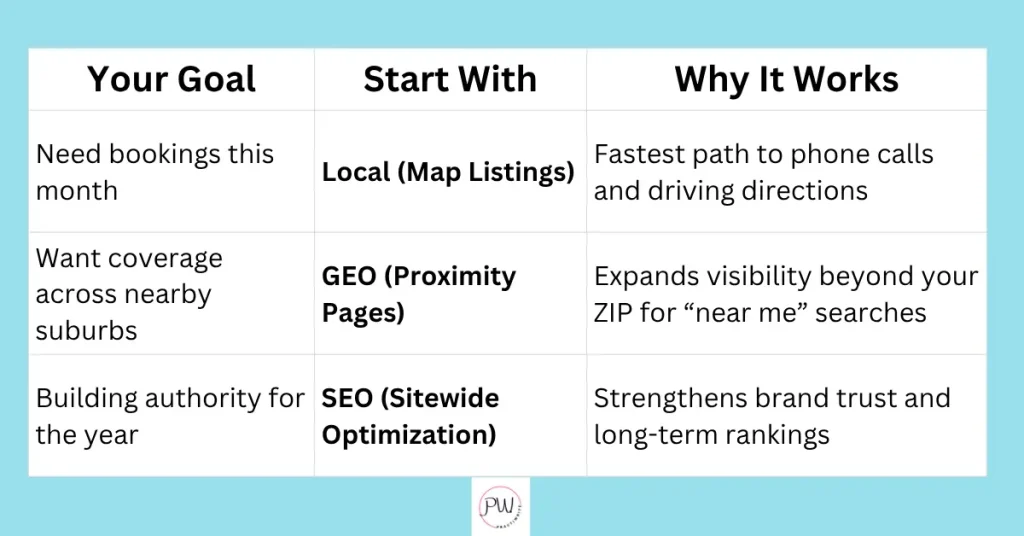
Budget Benchmarks + 30/60/90 Timeline
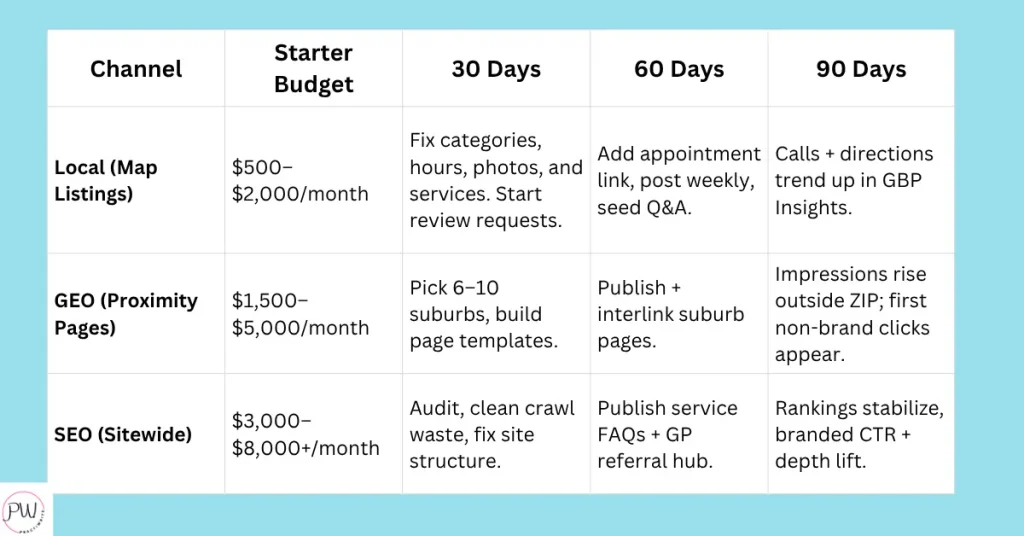
What Success Looks Like (By 90 Days)
- Local: Calls and directions up 10–30%
- GEO: Suburb pages earning first non-brand clicks
- SEO: Branded queries climbing and dwell time rising
Real result: One endodontic office added 25 new reviews, fixed GBP categories, and seeded weekly Q&As; calls jumped from 74 to 102 in 60 days.
90-Day Tracking Plan
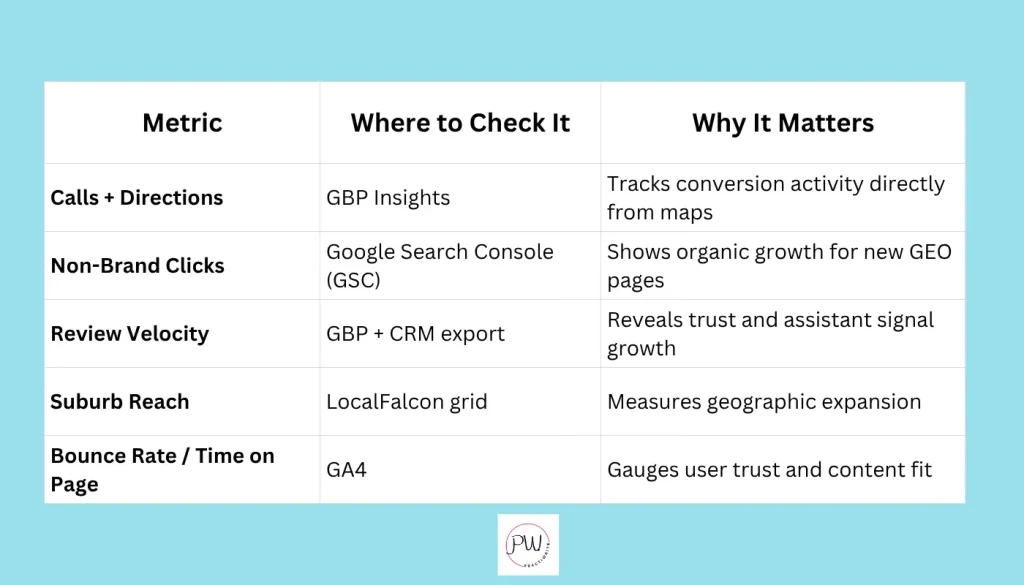
If Calls Aren’t Moving by Day 60
Before throwing more budget at it, check:
- Primary GBP category (must = Endodontist)
- Hours and “Open Now” accuracy
- Main photo + Q&A freshness
- Review volume + velocity
In 9 out of 10 cases, signal misalignment, not spend, is the problem.
Maintenance Matters
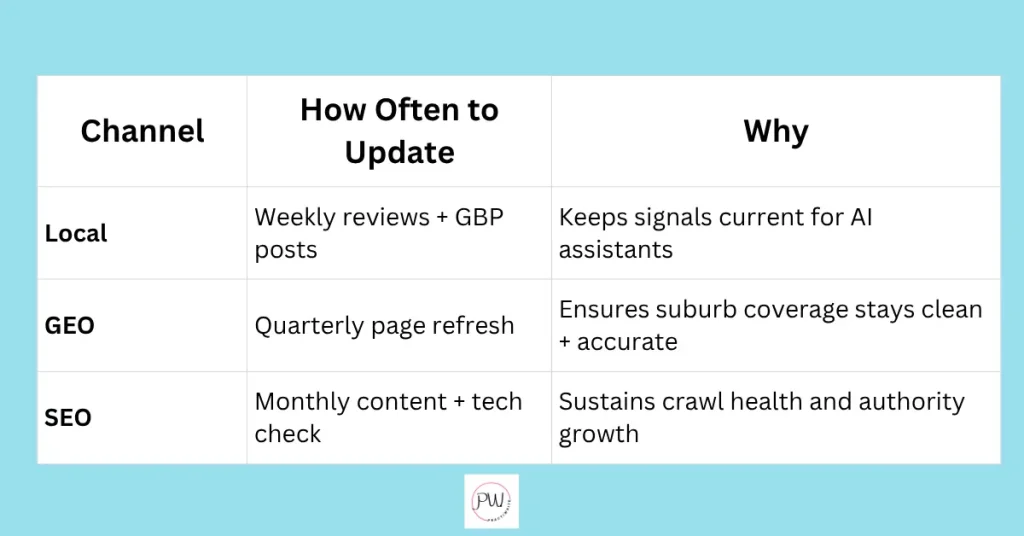
“Local results are based on relevance, distance, and prominence.”
— Google Business Profile Help
Final 5-Minute Action Plan (Today)
- Update your GBP categories
- Request three new reviews
- Add a same-day Q&A to your profile
- Post one fresh photo with EXIF data
- Set a reminder to recheck metrics in 7 days
Small moves, done weekly, compound faster than any single big spend.
Wrapping Up: From Clipboard to Clarity
That same clipboard on your front desk still starts the day; only now, your practice name is the one assistants read out loud when someone searches “same-day root canal near me.”
That’s not luck. That’s structure.
It’s your schema lined up, your reviews compliant, your hours synced, and your service pages clear enough for both Google and real people to understand.
When SEO, GEO, and Local all work together, your practice doesn’t just show up. You get chosen.
And that’s what this all comes down to: Clarity wins. Every time.
If you’re ready to see how this applies to your own endodontic practice, let’s build your Dental Practice Roadmap together.
We’ll map out exactly where your SEO and GEO signals stand today and what’s missing to make assistants quote you and patients call you first.
Book your Strategy Session now to see what your practice could be generating 90 days from today.
10+ year content strategist, writer, author, and SEO consultant. I work exclusively with dental practices that want to grow and dominate their local areas.
